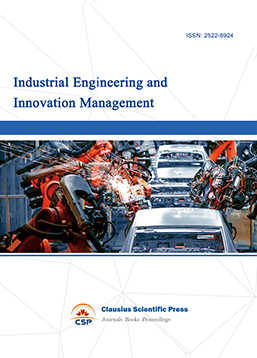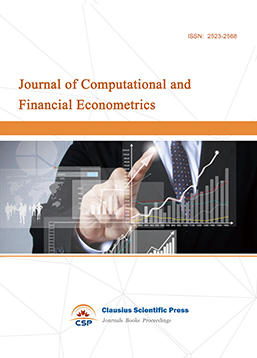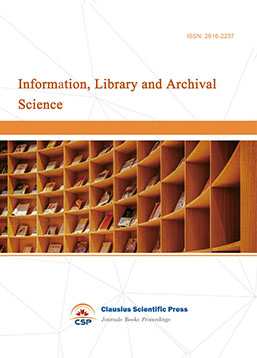The effect of entrepreneurship, dual innovation on firm growth performance under the digitalization perspective: Evidence from China
DOI: 10.23977/acccm.2024.060403 | Downloads: 29 | Views: 1000
Author(s)
Quan Zhou 1, Guibin Chen 2, Zixuan Chen 3, Jing Xu 4
Affiliation(s)
1 Management College, Beijing Union University, Beijing, China
2 Beijing Johamu Pharmaceutical Co., Ltd, Beijing, China
3 University of Chinese Academy of Social Sciences, Beijing, China
4 Science and Technology Division, Beijing Union University, Beijing, China
Corresponding Author
Jing XuABSTRACT
China's economy is changing from resource-driven to innovation-driven, and how Technology-Based small and medium-sized enterprises, as an active group of innovation, can realize sustainable growth has gradually become an important issue. Based on the resource-based theory, this paper utilizes the survey data of 166 Technology-Based small and medium-sized enterprises in Beijing to develop a research model to establish the interaction effects of entrepreneurship, dual innovation, digitization level and the growth performance of enterprises, and examines the mediating effect of dual innovation and the moderating effect of digitization level. The results show that entrepreneurship has a significant direct positive effect on enterprise growth performance and can indirectly affect enterprise growth performance through dual innovation. Meanwhile, the level of digitization plays a negative moderating role in the influential relationship between entrepreneurship and exploitative innovation, while it plays a U-shaped moderating role in the influential relationship between entrepreneurship and exploratory innovation.
KEYWORDS
Technology-Based Small and Medium-Sized Enterprises; Entrepreneurship; Dual Innovation; Digitalization Level; Growth PerformanceCITE THIS PAPER
Quan Zhou, Guibin Chen, Zixuan Chen, Jing Xu, The effect of entrepreneurship, dual innovation on firm growth performance under the digitalization perspective: Evidence from China. Accounting and Corporate Management (2024) Vol. 6: 20-33. DOI: http://dx.doi.org/10.23977/acccm.2024.060403.
REFERENCES
[1] Yan Huang, Qiuyan Tao, Fulin Zhu. Relationship Intensity, Knowledge Transfer and Innovation Performance of Technology-based SMEs[J]. Enterprise Economy, 2017, 36(12): 88-94.
[2] Haigang Wang, Gang Chen, Xu Cheng. The Risk Analyses and Countermeasures of Technology Innovation for High Tech Small and Mid-Sized Enterprises[J]. Journal of Shaanxi University of Science & Technology, 2012, 30(06):151-154.
[3] Penrose E T. The Theory of the Growth of the Firm [M]. Oxford university press, USA, 2009.
[4] Adner R, Helfat C E. Corporate effects and dynamic managerial capabilities[J]. Strategic management journal, 2003, 24(10): 1011-1025.
[5] Jin Chen, Ruixu Wang. A Review of Research on Top Management Teams[J]. China Management Informationization, 2010, 13(01): 78-81.
[6] Ping Nie, Ting Luo. Research on the Correction of Internal Control on the Relationship between Entrepreneurship and Enterprise Strategy[J]. Communication of Finance and Accounting, 2019(33): 87-95.
[7] Huaiying Zhang, Lu Li, Hui Jiang. Research on SMEs Performance Impact Mechanism from the Perspective of Relationship and Capability [J]. Chinese Journal of Management, 2021, 18(3): 353-361.
[8] Fengxia Liu. Entrepreneurship, Innovation Incentive and Enterprise Innovation Performance[J]. Communication of Finance and Accounting, 2019, 40(36): 55-58.
[9] Ruoyi Xi, Anqi Li, Exiu Zhang. Exploring the Influence Mechanism of Entrepreneurship on the Performance of Small and Medium-Sized Enterprises [J]. Modern Business, 2019, 19(02): 108-111.
[10] Guisheng Sun, Shaoqing Tang, Jianyuan Tao, Jiaming Yan. Internal logic analysis of entrepreneurship, innovation culture and high-quality development [J]. China Soft Science, 2024, (S1): 454-461.
[11] Junqiang Shen. The Relationship Between Network Embeddedness and Growth Performance of Logistics Enterprises—Based on the Mediation Effect of Absorptive Capacity [J]. Journal of Commercial Economics, 2021(22): 113-116.
[12] Weidong Guo, Junxia Hou. Impact of Key Resource Acquisition on the Growth Performance of New Venture Under the Background of Mass Entrepreneurship and Innovation Mediation Effects Based on Dynamic Capabilities[J]. Journal of Capital University of Economics and Business, 2021, 23(03): 86-100.
[13] Xia Gao, Linxing Lei, Fenfen Ma. Digital Finance, Financing Constraints and Business Growth[J]. Communication of Finance and Accounting, 2022(02): 68-71.
[14] Sha Lan, Haiqing Hu. Impact of Dual Innovation Dynamic Equilibrium on Sustainable Competitive Advantages of Enterprises [J]. Statistics & Decision, 2024, 40(05): 166-171.
[15] Wang C L, Rafiq M. Ambidextrous Organizational Culture, Contextual Ambidexterity and New Product Innovation: A Comparative Study of UK and Chinese High-tech Firms [J]. British Journal of Management, 2014, 25(1): 58-76.
[16] Wang Y, Lee J, Fang E, Ma S. Project customization and the supplier revenue–cost dilemmas: The critical roles of supplier–customer coordination[J]. Journal of Marketing, 2017, 81(1): 136-154.
[17] Yin Z, Gong X, Guo P, Wu T. What drives entrepreneurship in digital economy? Evidence from China[J]. Economic Modelling, 2019, 82: 66-73.
[18] Qingjiang Chen, Maofeng Wan, Yanmeng Wang. The Influence of Digital Technology Application on Ambidextrous Innovation of Enterprises—Empirical Test Based on Organizational Life Cycle[J]. Soft Science, 2021, 35(11): 92-98.
[19] Donghui Zhao, Xinbo Sun, Yu Qian, Dapeng Zhang. The Emergence of Organization Entrepreneurship in the Digital Age: Grounded Theory Analysis Based on Multiple Cases[J]. Human Resources Development of China, 2021, 38(07): 92-108.
[20] Changhong Bai. The Evolution of Entrepreneurship[J]. Nankai Business Review, 2019, 22(05):2+1.
[21] March J G. Exploration and exploitation in organizational learning[J]. Organization Science, 1991, 2(02): 71-87.
[22] Kai Yao, Xiaolin Li. The Interaction Effect Between Organizational Ambidexterity and Entrepreneurial Bricolage—A Case Study Based on Pet Food Industry[J]. Journal of Fudan University (Natural Science), 2021, 60(01): 1-13.
[23] Xiuhui Qi, Yifeng Wang, Zhengling Sun. Dual Innovation, Entrepreneur's Risk-Taking Tendency and Enterprise Performance[J]. Science & Technology Progress and Policy, 2020, 37(16): 104-110.
[24] Schumpeter J A. The Theory of Economic Development[M]. Boston: Harvard University Press, 2004.
[25] Drucker P F. Innovation and Entrepreneurship: Practice and Principles[J]. Social Science Electronic Publishing, 1985, 4(1):85-86.
[26] Mueller V, Rosenbusch N, Bausch A. Success patterns of exploratory and exploitative innovation: A meta-analysis of the influence of institutional factors[J]. Journal of Management, 2013, 39(6): 1606-1636.
[27] Baobao Dong, Songsong Cheng, Lan Zhang. Ambidexterity Innovation: Review and Future Research Agenda[J]. Chinese Journal of Management, 2022, 19(02): 308-316.
[28] Hongmei Chen, Min Liang, Penghua Qiao. Entrepreneurship, R&D Investment and Regional Innovation Performance[J]. The World of Survey and Research, 2021(03): 58-64.
[29] Min Zhang, Yili Zhang, Peipei Fan. The Game Between "I" Self-Cognition and "Me" Self-cognition of Entrepreneurs: A New Cognitive Perspective of Ambidextrous Innovation Path[J]. Foreign Economics & Management, 2016, 38(02): 3-15.
[30] Hui Xu, Wen Li. Empirical Study on Relationship Between Organizational Learning and Ambidextrous Innovation in High-Tech Enterprises[J]. Journal of Management Science, 2013, 26(04): 35-45.
[31] Renqiao Xiao, Jiajia Shen, Li Qian. The Influence of Digitalization Level on the Performance Of New Product Development: Based on the Mediating Role of Ambidextrous Innovation Capability[J]. Science & Technology Progress and Policy, 2021, 38(24): 106-115.
[32] Xiaodong Chen, Xiaoxia Yang. The Impact of Digital Economic Development on the Upgrading of Industrial Structure: Based on the Research of Grey Relational Entropy and Dissipative Structure Theory[J]. Reform, 2021,(03):26-39.
[33] Lin Xin, Xintong Meng. A Study on the Influence of Network Effects on the Innovation Performance of Digital Economy Enterprises[J]. Friends of Accounting, 2021(24): 57-64.
[34] Xifeng Lu. A Study on the Impact of Opportunity Innovativeness and Knowledge Acquisition on Firm Performance—A Case Study of Science and Technology-Based Firms[J]. Information Science, 2017, 35(05): 160-164.
[35] Covin J G, Slevin D P. Strategic Management of Small Firms in Hostile and Benign Environments[J]. Strategic Management, 1989, 10:75-87.
[36] Covin J G, Slevin D P. A Conceptual Model of Entrepreneurship As Firm Behaviour[J]. Entrepreneurship Theory and Practice, 1991, 16(1): 7-25.
[37] Zahra S A. A Conceptual Model of Entrepreneurship As Firm Behaviour: A Critique and Extension[J]. Entrepreneurship Theory and Practice, 1993, 17(4): 5-21.
[38] Jansen J J, Van Den Bosch F A J, Volberda H W. Exploratory Innovation, Exploitative Innovation, and Performance: Effects of Organizational Antecedents Environment Moderators[J]. Management Science, 2006, 52(11): 1661-1674.
[39] Yuehui Cui, Baoshan Ge, Baobao Dong. Ambidextrous Innovation and New Venture Performance: A Combined Moderating Effect Model Based on the Multilevel Network Structure[J]. Foreign Economics & Management, 2018, 40(8): 45-57.
[40] Rui Wang, Ming Dong, Wenhao Hou. Research on Digital Maturity Evaluation Model and Method for Manufacturing Enterprises[J]. Science and Technology Management Research, 2019, 39(19): 57-64.
[41] Lin Tian, Lulu Zhang. Establishment of Growth Evaluation System for Technology Based SMEs Based on Fuzzy ANP and TOPSIS[J]. Operations Research and Management Science, 2021, 30(02):184-190.
[42] Xiaoming Tian, Qinfeng Jiang, Zhongming Wang. The Empirical Analysis of Relationship Between Enterprises' Dynamic Capabilities and Entrepreneurial Performance[J]. Studies in Science of Science, 2008(04): 812-819.
[43] Chaohong Shen, Chongming Wang. The Exploration on the Entrepreneurship Performance Structure and the Explanation Based on Contract[J]. Nanjing Journal of Social Sciences, 2011(01): 36-42.
[44] Fornell C, Larcker D F. Evaluating Structural Equation Models with Unobservable Variables and Measurement Error[J]. Journal of Marketing Research, 1981, 24(02): 337-346.
[45] Baron R M, Kenny D A. The Moderator-Mediator Variable Distinction in Social Psychological Research: Conceptual, Strategic, and Statistical Considerations [J]. Journal of Personality and Social Psychology, 1986, 51(06): 1173-1182.
[46] Robinson C, Schumacker R E. Interaction Effects: Centering, Variance Inflation Factor, and Interpretation Issues[J]. Multiple Linear Regression Viewpoints, 2009, 35(01): 6-11.
[47] Lu Zhu. The Effect of Entrepreneurial Innovativeness on Firm Growth Performance in A Dynamic Environment[D]. Yunnan University, 2019.
[48] Song Tang, Xuchuan Wu, Jia Zhu. Digital Finance and Enterprise Technology Innovation: Structural Feature, Mechanism Identification and Effect Difference Under Financial Supervision[J]. Journal of Management World, 2020, 36(05): 52-66+9.
| Downloads: | 38773 |
|---|---|
| Visits: | 662517 |
Sponsors, Associates, and Links
-
Information Systems and Economics

-
Accounting, Auditing and Finance

-
Industrial Engineering and Innovation Management

-
Tourism Management and Technology Economy

-
Journal of Computational and Financial Econometrics

-
Financial Engineering and Risk Management

-
Social Security and Administration Management

-
Population, Resources & Environmental Economics

-
Statistics & Quantitative Economics

-
Agricultural & Forestry Economics and Management

-
Social Medicine and Health Management

-
Land Resource Management

-
Information, Library and Archival Science

-
Journal of Human Resource Development

-
Manufacturing and Service Operations Management

-
Operational Research and Cybernetics


 Download as PDF
Download as PDF